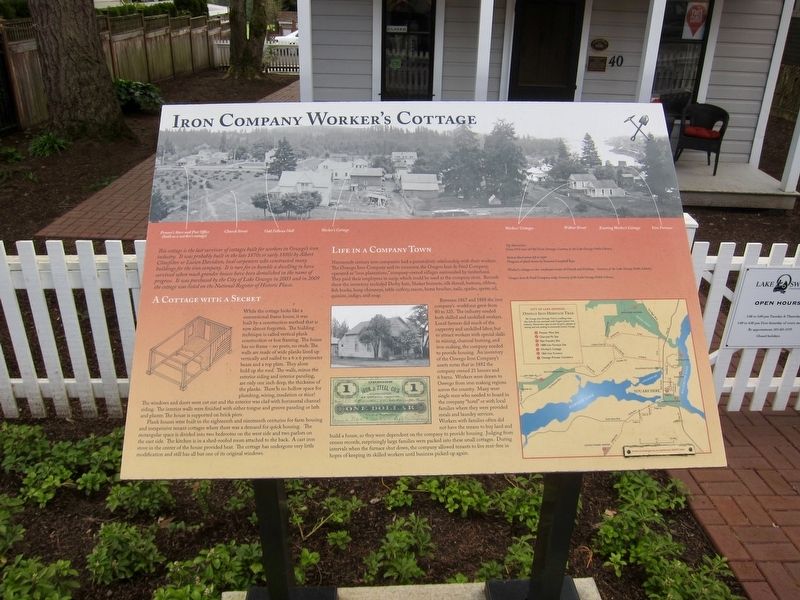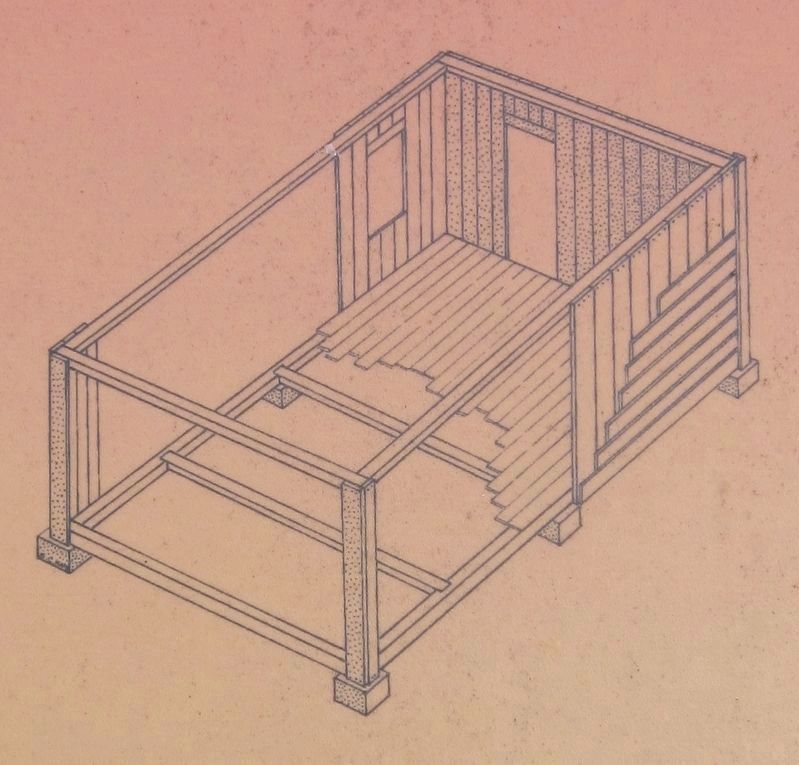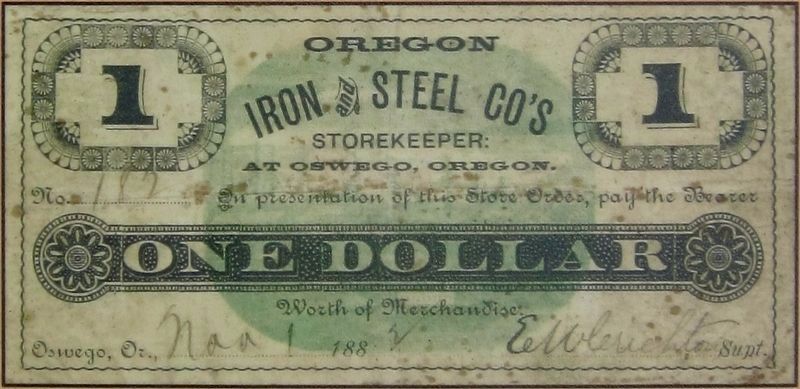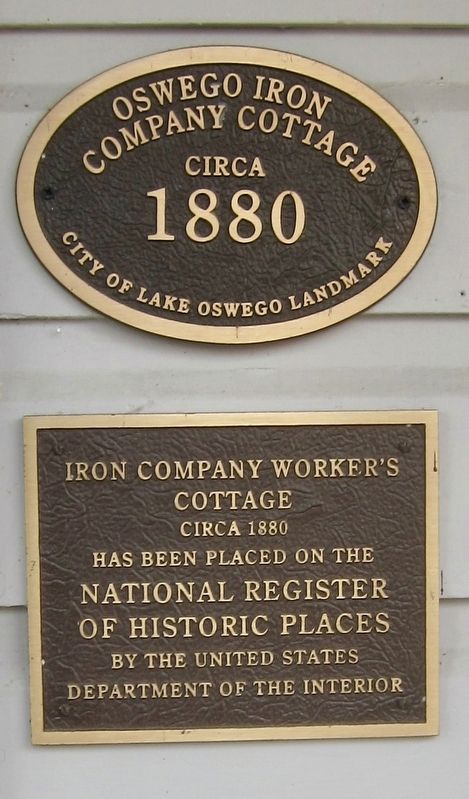Lake Oswego in Clackamas County, Oregon — The American West (Northwest)
Iron Company Worker's Cottage
This cottage is the last survivor of cottages built for workers in Oswego's iron industry. It was probably built in the late 1870s or early 1880s by Albert Clinefelter or Lucien Davidson, local carpenters who constructed many buildings for the iron company. It is rare for so humble a dwelling to have survived when much grander houses have been demolished in the name of progress. It was purchased by the City of Lake Oswego in 2003 and in 2009 the cottage was listed on the National Register of Historic Places.
A Cottage with a Secret
While the cottage looks like a conventional frame house, it was built by a construction method that is now almost forgotten. The building technique is called vertical plank construction or box framing. The house has no frame — no posts, no studs. The walls are made of wide planks lined up vertically and nailed to a 6 x 6 perimeter beam and a top plate. They alone hold up the roof. The walls, minus the exterior siding and interior paneling, are only one inch deep, the thickness of the planks. There's no hollow space for plumbing, wiring, insulation or mice! The windows and doors were cut out and the exterior was clad with horizontal channel siding. The interior walls were finished with either tongue and groove paneling or lath and plaster. The house is supported on brick piers. Plank houses were built in the eighteenth and nineteenth centuries for farm housing and inexpensive tenant cottages where there was a demand for quick housing. The rectangular space is divided into two bedrooms on the west side and two parlors on the east side. The kitchen is in a shed-roofed room attached to the back. A cast iron stove in the center of the house provided heat. The cottage has undergone very little modification and still has all but one of its original windows.
Life in a Company Town
Nineteenth century iron companies had a paternalistic relationship with their workers. The Oswego Iron Company and its successor, the Oregon Iron & Steel Company, operated as "iron plantations," company-owned villages surrounded by timberland. They paid their employees in scrip, which could be used at the company store. Records show the inventory included Derby hats, Shaker bonnets, silk thread, buttons, ribbon, fish hooks, lamp chimneys, table cutlery, razors, horse brushes, nails, spades, sperm oil, quinine, indigo, and soap.
Between 1867 and 1888 the iron company's workforce grew from 80 to 325. The industry needed both skilled and unskilled workers. Local farmers did much of the carpentry and unskilled labor, but to attract workers with special skills in mining, charcoal burning, and iron making, the company needed to provide housing. An inventory of the Oswego Iron Company's assets notes that in 1882 the company owned 21 houses and 6 barns. Workers were drawn to Oswego from iron making regions across the country. Many were single men who needed to board in the company "hotel" or with local families where they were provided meals and laundry services. Workers with families often did not have the means to buy land and build a house, so they were dependent on the company to provide housing. Judging from census records, surprisingly large families were packed into these small cottages. During intervals when the furnace shut down, the company allowed tenants to live rent-free in hopes of keeping its skilled workers until business picked up again.
Topics. This historical marker is listed in this topic list: Industry & Commerce. A significant historical year for this entry is 2003.
Location. 45° 24.776′ N, 122° 39.786′ W. Marker is in Lake Oswego, Oregon, in Clackamas County. Marker is on Wilbur Street west of Durham Street. Touch for map. Marker is at or near this postal address: 40 Wilbur Street, Lake Oswego OR 97034, United States of America. Touch for directions.
Other nearby markers. At least 8 other markers are within walking distance of this marker. George Rogers House - 1929 (a few steps from this marker); Old Town (within shouting distance of this marker); Lakewood School - 1928 (about 400 feet away, measured in a direct line); Old Peg Tree (about 800 feet away); Green Street (approx. 0.2 miles away); Salamander (approx. 0.2 miles away); Oswego Landing (approx. 0.2 miles away); The First People (approx. 0.2 miles away). Touch for a list and map of all markers in Lake Oswego.
Also see . . . Lake Oswego Preservation Society. Website homepage (Submitted on July 12, 2018.)
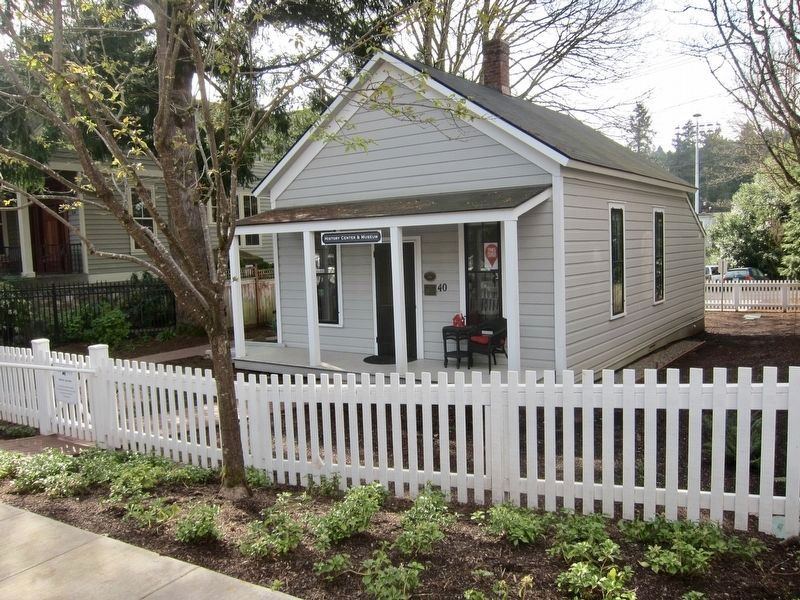
Photographed By Andrew Ruppenstein, March 29, 2018
6. Former Iron Company Worker's Cottage - now a history center and museum
According to the Lake Oswego Preservation Society's website, the history center/museum is open every Tuesday, Thursday, and first Saturday of the month from 1:00-4:00 pm, as well as by appointment.
Credits. This page was last revised on October 9, 2023. It was originally submitted on July 12, 2018, by Andrew Ruppenstein of Lamorinda, California. This page has been viewed 255 times since then and 18 times this year. Photos: 1, 2, 3, 4, 5, 6. submitted on July 12, 2018, by Andrew Ruppenstein of Lamorinda, California.
